This website uses cookies so that we can provide you with the best user experience possible. Cookie information is stored in your browser and performs functions such as recognising you when you return to our website and helping our team to understand which sections of the website you find most interesting and useful.
British Columbia: wild and free wine country
Filippo Bartolotta travels to western Canada to explore how, despite freezing winters and summer wild fires, Okanagan Valley’s winemakers are making the most of the region’s terroirs.
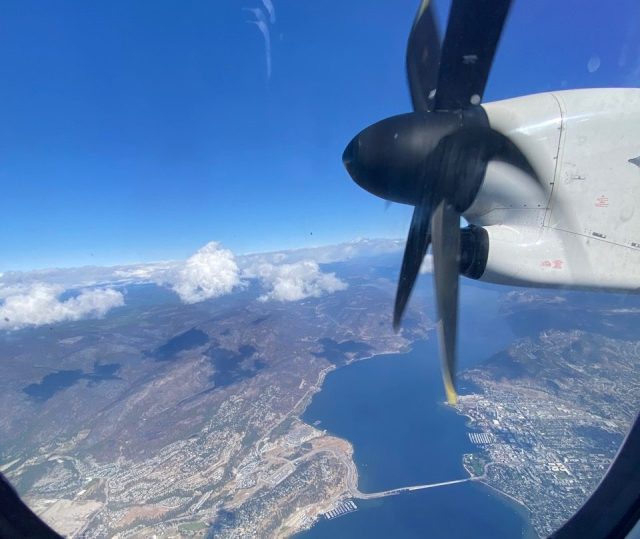
Winters down to -30°C, desert-like hot summers, wild fires, rattle snakes and brown bears. Fancy becoming a wine maker in British Columbia’s Okanagan Valley?
I would in a heartbeat, and here is why. Four (spectacular) hours drive form east of one of the most beautiful cities on the world: Vancouver. From the powerful panoramic road we leave Stanley Park across the Lion’s Gate Bridge with a mighty sense of adventure. Very soon that Metropolis feeling will disappear and the only word that comes to mind as of this point is nature. Rivers, lakes, never-ending forests and tiny villages only every once in a while: Squamish, Whistler, Pemberton and Lilloet. This last one was a bit off track but I wanted to take a pick at the city where in 1857 the British Columbia gold rush along the Fraser river started and visit Fort Berens Winery. I had tasted its delicious Cabernet Franc during the 2023 Vancouver Wine Festival.
Lillooet is literally a road with a few wooden houses, a local inn, a pub and a few small-town shops and a majestic view on the Fraser River Valley. The gold rush here apparently wasn’t one of the most successful but it drew a lot of Americans to the area. As a matter of fact, two years later in 1859 and 200 miles east in Kelowna a French priest planted the first vinez in British Columbia. This first attempt was followed by a few others, but was soon stopped by Prohibition from 1912 to 1922. We then need to wait till the 70s to see more vineyards planted, although still Vitis labrusca. One happy mistake though brought the arrival of the first Vitis vinifera plant. Dick Stewart, owner of Quail’s Gate Winery, purchased some hybrid varieties but he was given a Chasselas instead, which is still a big hit today.
In the late 80s with the NAFTA agreement the British Columbia Vinters Quality Alliance was created, an organisation which was the true ignition of the boom of wineries and wine culture of today. In fact from the 19 wineries in 1990 today British Columbia has 330 wineries and over 4500 hectares, which is more or less half the size of Valpolicella or Chianti Classico, a qaurter of Napa Valley, or less than 2.5% the size of Bordeaux. The valley spreads approximately across 200 kilometres in a north-south direction from the Osoyoos lake on the border between Canada and the United States to Vernon along the Okanagan lake on the northern limit and the vines are located between 300 and 600 metres above sea level.
Right in the heart of it is the town of Kelowna (it derived its name from the Syilx word for grizzly bear) which could be considered the wine capital. The Regional Wine Museum, is a good starting point for learning about the history of local viticulture.
One of the most intriguing element of British Columbia’s terroir is the fact that it is located on northernmost edge of the network of deserts that stretches from Mexico to the USA and finishes here in Canada where the South Okanagan Valley is. Thanks to its location, there are very varied climates and terrains so much so that we can talk about two major mesoclimates: a southern area, where the Osoyoos desert generates very hot in summers and the soil gets very dry, and the northern area, where the climate is milder and the landscape is noticeably greener.
The annual precipitation between snow and rain doesn’t go over 415 mm, which is more or less what you get in Marsala in Sicily near to the African coast. So what about the famous Vancouver rain? While Vancouver is a coastal area, the wine region itself is cut off from the Pacific rains because of the few hundreds miles of Mountain Range between Vancouver and the vineyards.
Given this hot climate conditions, is it right to expect overripe, bold and jammy wines?
It would be if there weren’t a dramatic diurnal temperature swing, which can be as much as 30°C! Also, one has to keep into account that these vineyards are north of the 49° parallel, which means the winters are very cold (the last two winters temperature dropped down to -30°C, unfortunately killing many plants) and the growing season is short. As a result British Columbian wines are all about intense fruit flavours, zippy acidity and ability to age, despite the low alcohol. Only a tiny percentage of the wines I have tasted this year during my first visit in April and my second visit during the autumn were big and extractive. As a matter of fact, the fine texture and mineral juiciness most wines have seem to reflect also the complex mix of soil formations, structures and types which, for the most part, are glacial till: finer then sand deposits of clay with some calcareous and volcanic veins.
I also had the feeling that the closer the vineyards get to the mountain hills and the rockier the soil gets, the more minerality is added to the wines. It maybe is still too early to have a clear geological-wine related sub-zoning system here, and definitely it is for my little experience here, but this very new wine feels already like a classic one.
During my first early morning jog across the vineyard at Burrowing Owl Estate I felt the cold nights one gets in desert areas – I wished I had brought a wind stopper – which bring moisture to the plants. This southern area between Osoyoos and Oliver is famous for relatively opulent Bordeaux style wines and some pure Cabernet Franc. So, while trying to close a ring to get back to my room, I inadvertently got carried away towards the sunnier side of the rocky hill and the sun was already shining bright some serious heat! I barely made it on time to take a shower and meet for a wine breakfast with owners Chris Wise and Kerri Wyse-McNolty and their winemaker Kent MacDonald. Tasting all the wine range I got away with that idea of vibrant red fruit driven reds and crunchy whites.
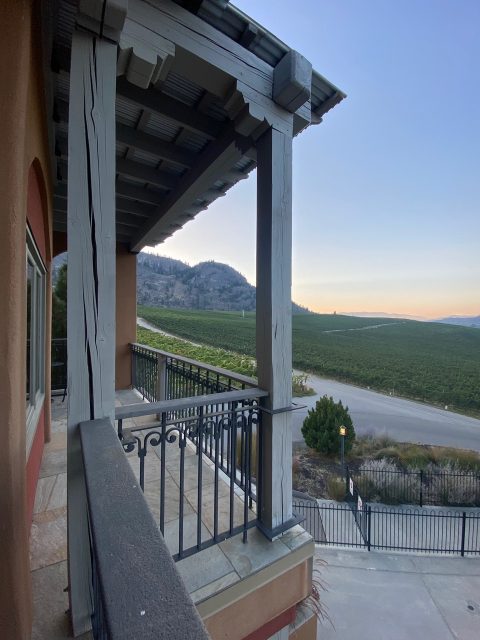
The Burrowing Owl Estate Pinot Gris 2022 was singing in the glass with some white pepper, mango and a floral twist (possibly given by some Gewurtztraminer) and a touch of smokey creaminess. With the Burrowing Owl Estate Cabernet Franc 2020, I was actually impressed by the bright red fruit and the gastronomic herbal and peppery notes of this wine. The Burrowing Owl Estate Athene 2019 was a stunning showcase of graphite, balsamic and blueberry fruit with an intense finish. The unusual 50/50 Syrah and Cabernet Sauvignon blend, I believe is a great a benchmark of an ideal British Columbian classic red with some serious ageing potential.
Guided by Arnica Rowen (Canada’s next MW), our second stop was basically five minutes drive north of the US border at La Stella Winery right on the Osoyoos lake side was a treat as we tasted mostly Sangiovese and Merlot 2023 straight form the barrel with wine maker Dave Marchand.
Upon arrival, the lavender orchards and the perfectly managed vineyards on the lake gave me that “paradise” feeling. And it is very difficult to think that this gentle landscape can turn into a frost bitten countryside during the winter. Before Christmas more than 28 plots of vines kwere illed by the cold temperatures, so this vintage will be much smaller than average, Marchand explained. The quality though does not seem to be affected at all and on the contrary the “Maestoso block one” Merlot shows the smoothest and the most seamless tannins together with a great sapid tension and a spicy character.
We then tried some La Stella Sangiovese which started with vintage 2014. The approach is once again more “Old World” style with little or no use of new barriques and a “less is more” attitude to wine making. The result is a transparent sour cherry, liquorice and leather-driven Sangiovese with some hints of balsamic reminding more of a Chianti Classico for its transparent vibrancy than the opulence of a Brunello di Montalcino. I could have spent the whole morning at La Stella but our schedule didn’t allow and off we went to the next winery.
Half an hour drive north passing Mt Kobau to the left. Liquidity Winery is located on the red rocky territory of the beautiful Okanagan Falls on the Skaha Lake and evergreen Ponderosa pines looking at the Vaseux Lake. If it weren’t for the vineyards you’d feel as if you were in a wild west movie set! The winery owned by wine entrepreneur Anthony von Mandl is on top of a hill with a lake view to die for. Arnica and I were greeted with a refreshing glass of flinty and tropical Chardonnay and warmly escorted to our table where winemaker Amy Paynter is keen to discuss wines with us. The vineyards extend between Lake Vaseux and the McIntyre Bluff.
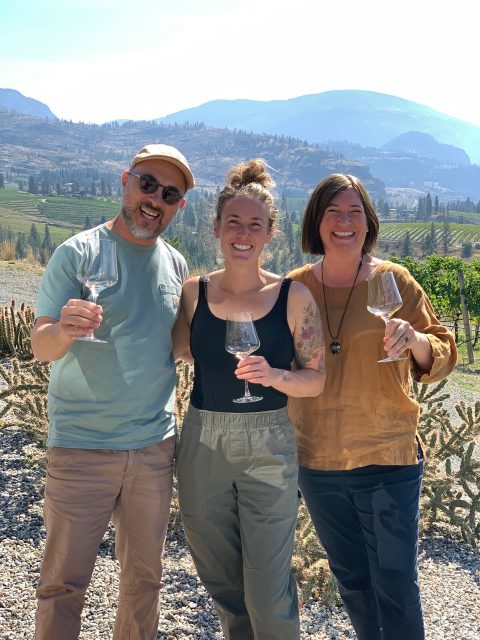
Liquidity Viogner 2020 combined floral notes of jasmine tea with mango juice and a lemon peel note. Mineral power with a great acidity plus more concentrated apricot notes. Acacia honey and a wonderful drinkability which went perfectly with a delicious carrot and ginger soup and prawn ceviche.
The young and very focused New Zealand-born winemaker Paynter told us of her love story with Okanagan Falls and the fruit of Viognier, and the estate Viogner is a clear witness to her love. Given how much we loved the wine, she treated us to a new label: Liquidity Viogner Atelier 2022 (en primeur, not for sale yet). Beeswax, honeysuckle, apricots, matcha, vanilla and lemon curd. On the palate it shows some papaya pure and uplifting cardamom spices. The amphora and concrete fermentation and fining of this Viogner adds extra layers of texture and structure but still retaining finesse and length.
Arnica and I carried on northbound, going from one lake side winery to another. This time we stop at Poplar Grove winery where we are treated to a wine tasting lunch on the patio overlooking Lake Okanagan. Founded in 1993, Poplar Grove Winery is one of the original five wineries on the Naramata Bench. Chef Stacy Johnston brought a selection of the juiciest British Columbia tapas while the food & beverage manager Michael ZiffI pampers us with a selection of wines.
Lakeview Rosé 2022, a single vineyard Malbec with an intense mountain strawberries and white peach nose and a refreshing watermelon and dry raspberries, had a lingering finish. Reserve Chardonnay 2021 proved to be extremely round, creamy and buttery, and maybe one of the fullest bodied wines I tried during the trip with a marzipan and vanilla stick note, some toasted almond and white melon, and a remarkable smokey finish (summer 2021 saw some wild fires and I wonder if some of that contributed some of the smoke).
After lunch we just drove for 10 minutes to our next lakeside winery: Lake Breeze, located on the Naramata Bench, was named for the winds that blow across the bluffs. The MacIntyre family purchased the property in 2001. The vines themselves were planted in 1985, and president & winemaker, Garron Elmes (and George, his faithful dog) has been taking care of this winery since 1995. Garron is definitely one of the most skilful and laidback winemakers I have ever met. He casually cracks open a dozen wines for us while we enjoy a very unfiltered and enlightening conversation about wine.
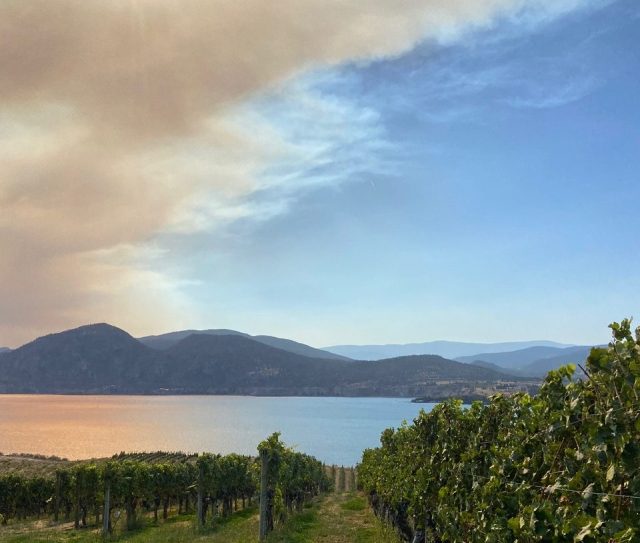
His Sauvignon Blanc 2022 is packed with loads of tropical and citrus fruits and despited the 7 grams of sugar has a Japanese katana-like acidity. The further north we drive, the more vibrant the wines seem to become. Pinot Blanc 2022, as Garron describes it, is a “quaffable patio wine which I still like to make although now Pinot Gris has become more popular, but I like the Pinot Blanc fruit.”
The interesting part came when he cracked open a bottle of Sémillon 2017: a spectacular almond and white pear driven wine with so much tension on the palate, just like a cold shower in the morning. Viscosity, creaminess and more hazelnuts, orange blossom and bees wax!.Pinotage Berg 2019 offered smoked bacon and pepper with liquorice with a sandal wood complexity and some amazing black fruit. Red dry fruit, amazing acidity and a perfect tannic management. A very lingering red fruit driven Pinotage, one of the best I have ever had!
Time to rest and stop at Naramata Inn. An elegant, warm hotel and restaurant on the Okanagan lake with over a hundred years of history. Here, during dinner, we try a few wines with from the Naamata Bench district reflecting the minerality of the granite soil brought by the glaciers and settled into icy lakes contrasted by the dry desert air, Naramata is a peaceful and slow-living village which has been taken care of by the syilx people since time immemorial. Drinking La Frenz Naramata Estate Knerr Vineyard Semillon 2022 was the best opening we could have hoped for our dinner: a grassy, grapefruit driven white with a great minerality.
French Door Fleur 2022 proved to be the lightest and brightest red I drank in British Columbia. with a combination of raspberries, liquorice, and delightful earthy notes. Mirabel Vineyards Reserve Pinot Noir 2019 had a white pepper and red cherry aroma with a wonderful complexity of cola and violets and a velvet plum and tobacco leaf palate. Echo Bay Vineyard Okanagan Falls Synoptic 2020 was a full bodied Bordeaux blend packed with blackcurrants, dry herbs, underbrush and a balsamic touch. Unexpectedly vibrant on the palate with a great energy and juiciness given its body.
The morning after Arnica and her wonderful daughters and I kayaked Lake Okanagan, exploring the quite and beautiful shores of Naramata before heading north on the other side of the lake towards Niche Wine Co to meet with Joanna and James Schlosser founders and winemakers at Niche. A tiny garage-winery nestled in the middle of the mighty Ponderosa pine forest and manned by this incredibly resilient, innovative and creative couple.
This last visit was a wake up call for me to witness the magic but also scary power of nature of the British Columbia wines. While 2022/23 winter killed many vines for the ice and cold, summer 2023 was the summer of wild fires. This winery was spared from the fires by just a few metres. The forest above was totally burned and Joanna and James had to escape the fires to save their lives. Only the presence of the vineyard stopped the fires but, when a miracle seemed to have happened, one of the massive pines crashed through the fence and a big bear stormed in to harvest every single berry. The happiness of survival and the saved winery though was already a massive gift and so we went on tasting the wines.
“The harvest takes place late in October, we pick when the snow is already there,” James shared.
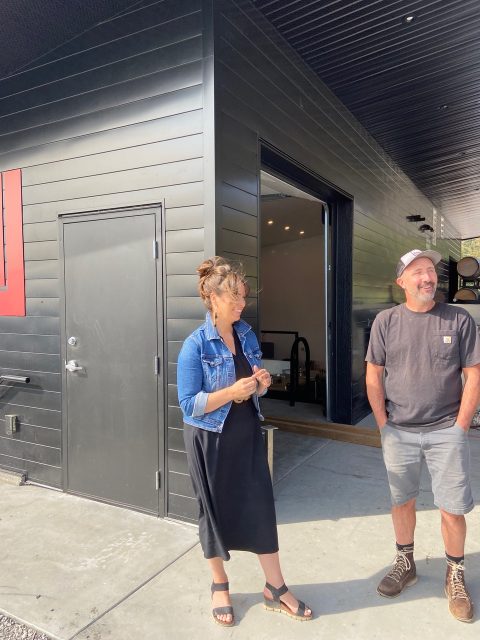
Niche Wine Co. Gewurtztraminer 2021 has an intriguing burnt fennel seeds and liquorice note, a lot of lychee and white plumes and a delicious flinty mouthful.
Niche Wine Co. Rosé 2022 is an elegant and crunchy Pinot Noir with a savoury and sapid finish with a little oak spices and a round almond texture despite the 100% malo.
Joanna is very keen to take about their attempt and experimental approach to handle the “wild fires” smokey vintages. “We have to work with what nature gives us and we can’t just complain about it,” she said.
With the 2021 vintage, James, a very precise and technical winemaker, worked on two different experiments to reduce the smoke traits in the wines: “Yes, one can use carbon filters or reverse osmosis to get rid of the smoke taint but I wanted to work with it rather then eliminate it so in one case I decided to handle the Pinot Noir using no new oak at all, only a few days of skin contact while with another batch I went for a wild slow fermentation, a long maceration with the skin and newer oak.”
This results in two opposing wines. Niche Wine Co. Near&Far Pinot Noir 2021 is the blend of two different vineyards, one closer to the winery and a distant one which showed the bright force of Skywalker with a fantastic red berry crush, floral complexity, underbrush and sweet spices, while Niche Wine Co. Wild&Free Pinot Noir 2021 is the dark side of the force with more concentration, tannic structure, tobacco and petrol/smoky notes.
I definitely preferred the first versio,n but what was amazing is the low alcohol content, always around 12%, and the intense body and length of these wines. As I was listening to James and Joanna’s stories, I remembered Dave at La Stella’s loss of 28 plots in the winter. I looked at Arnica to express how sorry I felt and she looked at Joanna and Dave, exchanging warm smiles.
This is the British Columbia wine scene. A group of Wild West talented vignerons and wine makers who share the pleasures and pains of this dramatically beautiful land with a remarkable sense of acceptance, resilience and gratitude at once. Mother Nature here seems very active in giving and and taking, which is maybe why people here seem to be driven by one major value and asset: collaboration.
Yes, they are a determined and competitive group of entrepreneurs, but they never ever stop being generous, helpful to one another and open to the rest of the world. British Columbia makes some amazing wines, and it is such an unusual and fascinating place that I can see why one would want to live here, sipping wine along highway 97, among vineyards and green mountains over garden-like lakes.

